It’s never been more difficult to identify and attract top-level talent to your company. This has become a major challenge for most businesses, but there is a simple way to make this process easier — aptitude testing. These tests provide an objective evaluation of talent, enabling you to hire the right person for your business. Aptitude tests are also extremely valuable when it comes to internal promotions and succession planning, driving informed decisions to better your company’s future outlook.
Through this expert guide from Thomas International, we will explain why aptitude testing has become so important for a successful HR strategy and how using it can strengthen your business long-term. We’ve included several resources to help you understand what conducting aptitude tests involves, what each test measures, and how they're scored. Finally, we’ve included free sample questions to illustrate what candidates may expect when taking these tests.
What are aptitude tests?
Aptitude tests are cognition-based assessments designed to evaluate a person’s ability in a particular skill or field of knowledge. They involve repeated assessments of skill and ability without prior knowledge and can be used to measure a variety of different cognitive abilities, including problem-solving, critical thinking, or spatial reasoning among many others. The candidate will be presented with a series of multiple-choice questions with only a single correct answer, and results will be compared across a group average.
Aptitude tests for hiring and recruitment have become increasingly popular in recruitment as they enable employers to limit bias and find the most suitable candidate for a role. Through evaluating cognitive abilities, employers can gain insight into how quickly and effectively a prospective new hire is likely to learn new skills and adapt to novel situations. Aptitude testing is also an excellent way to compare candidates against each other and quickly identify those who are likely to succeed in the role. All of this allows you to make informed decisions that will reduce the risk of costly hiring mistakes, while also allowing you to more accurately predict the job performance of any prospective hires.
Many of the world’s largest and most successful companies use aptitude testing as part of their recruitment processes. Google is famous for its rigorous and data-driven hiring process, where it utilises an aptitude test called the General Cognitive Ability test (or Wonderlic test) to evaluate candidates’ problem-solving and abstract reasoning skills. Other companies well known for their use of aptitude testing include IBM, Ernst & Young, and Procter & Gamble.
What are the different types of aptitude tests?
There are a wide number of different types of assessments that fall under the remit of aptitude testing. Each type can be used to measure different abilities and skills that may be relevant to a particular role or position. Using aptitude tests can be extremely beneficial to your recruitment process, but it’s important to ensure you select the correct type of test to fit the role you’re hiring for and the industry you operate in.
Below we explore a range of different aptitude tests that measure everything from cognitive ability and general intelligence to more specific skills and abilities, such as mechanical reasoning. Understanding what each test measures will be invaluable in helping you decide which is most appropriate for aiding your recruitment process.
Numerical reasoning tests
One of the core sections of psychological assessments, numerical reasoning evaluates a candidate’s numerical aptitude and strength. Tests measure performance with tasks based on several problems and assess basic capabilities as well as the ability to interpret and analyse data. Importantly, these tests not only measure basic numeracy skills such as simple arithmetic but also assess a candidate's ability to interpret numerical data such as tables and graphs.
In certain job roles, particularly those in the fields of finance or data analysis, these skills are incredibly important. Through these tests, finance and accounting companies will be able to easily predict how well a candidate will be able to analyse balance sheets or cash flow statements. Data analysis firms will be able to assess how a candidate draws accurate and unbiased conclusions from a large set of data. By accurately assessing these skills employers can be confident that new hires will have the appropriate skills to succeed from day one.
Sample question:
A company made a profit of $10,000 in the first quarter and $20,000 in the second quarter. What was the average quarterly profit for the company?
A. $10,000
B. $15,000
C. $20,000
D. $30,000
To find the answer, add the profit from the two given quarters together, before dividing by the number of quarters (in this case, 2).
Correct Answer: B
Verbal reasoning tests
Verbal reasoning is another core section of aptitude testing. Designed to assess comprehension and the ability to understand written passages, they commonly use questions that involve true, false, or cannot say responses based on the interpretation of the written content. These tests can identify people who jump to conclusions, misinterpret information, or allow their biases to dictate their answers.
In roles that require strong communication skills, such as marketing or journalism, these tests will allow employers to understand how well a candidate can understand and analyse important written information. Candidates will have to quickly understand and communicate complex ideas concisely, while also thinking critically about the information in front of them.
Sample question:
No cheap earrings are solid gold.
All children’s earrings are cheap earrings.
Which one of the following statements is definitely true based on these statements?
A. All children’s earrings are solid gold.
B. No children’s earrings are solid gold.
C. Some children’s earrings are solid gold.
D. Some children’s earrings are not solid gold.
To answer this question, you can only look at the given information. We know that cheap earrings are not solid gold. We know that children only have cheap earrings. This means no children can have solid gold earrings, as all of their earrings are cheap.
Answer: B
Diagrammatic reasoning tests
The final core section of most aptitude testing is diagrammatic reasoning, which tests a candidate’s ability related to logical reasoning and problem-solving. This is often referred to as abstract or inductive reasoning and usually involves sequences, patterns, and sometimes numbers. These tests help assess the ability to recognise the rules of a pattern or sequence and apply that knowledge to identify the appropriate answer.
Diagrammatic reasoning can be of particular use when hiring for roles that require strong visual thinking and problem-solving skills, such as design or engineering roles. Strong scores in these tests could indicate to an engineering firm that a candidate will likely be well-suited to working with complex diagrams or schematics. Likewise, a design company might use these tests to determine how well a candidate can identify patterns and visual relationships — a key task when adapting a design brief.
Sample question:
Examine this selection of shapes and choose what should come next in the series.
⬥▲◼⬦△…
A. ◻
B. ▼
C. ◁
D. ⭘
If we examine the pattern, we can see that the order of the shapes appears to be consistent. A diamond is followed by a triangle, followed by a square. We can also see the first set of shapes is all black, with the second set all white. A square would be the next logical shape to continue the consistent order, and it should be white to complete the set.
Answer: A
Situational judgement tests
Unlike the aptitude assessments mentioned so far that examine general intelligence and cognitive reasoning, situational judgement tests focus on how well you make judgements and decisions in specific work-related scenarios. This will allow an employer to determine a candidate’s approach to problem-solving and decision-making by providing them with a series of hypothetical workplace scenarios and asking them to choose and even justify their reaction.
This is of particular importance in roles where effective communication, strong decision-making, and well-developed interpersonal skills are highly valued. Areas such as customer service and law enforcement both rely heavily on this type of testing to evaluate how prospective hires will handle difficult situations.
E-tray or intray exercises
E-tray or intray exercises are used to understand how capable a candidate is at managing their workload. It assesses time management, prioritisation skills, decision-making, and general attention to detail by providing them with a range of work-related tasks that need to be prioritised and responded to. These types of assessments are more common for junior or graduate positions where the candidates in question may have little to no real workplace experience. If your business is in the legal or finance sectors, these tests could be very valuable when hiring for any administrative roles.
Inductive reasoning tests
Inductive reasoning tests fall within the category of diagrammatic reasoning tests and assess many of the same skills, including problem-solving, critical thinking, and attention to detail. Often they will require candidates to select answers based on incomplete or ambiguous information to test their analytical thinking. Candidates will need to quickly examine and interpret new information and deploy logical reasoning to come up with the correct answer. Businesses involved in information technology or science and research typically utilise these tests heavily during recruitment.
Cognitive ability tests
Cognitive ability testing is an overarching term for aptitude testing that covers a wide range of aspects related to general intelligence, including verbal, numerical, and spatial reasoning skills. Instead of focusing on one single ability, these tests provide employers with a more broad assessment of a candidate's abilities, allowing more informed decisions to be made across a wide faculty of skills. Scoring for cognitive ability testing may be conducted as one overall score across all sections or analysed in each section individually to give a more detailed insight into personal strengths and weaknesses. Being able to quickly understand a candidate’s general mental capacity and ability to process information is one advantage of these more general tests.
Mechanical reasoning tests
Mechanical reasoning tests are used to assess a candidate’s understanding of mechanical concepts and principles. They are typically related to how a candidate will perform in a practical environment and often require a high level of technical prowess. Candidates may have to solve a series of mechanical problems, interpret technical diagrams or schematics, or display their knowledge of scientific concepts such as force, motion, or energy. These tests are often used in roles within fields such as engineering, science, or the army.
Watson Glaser tests
Watson Glaser tests assess a candidate’s critical thinking skills and are most commonly used within the legal sector. These tests are designed to evaluate a candidate’s capacity to analyse complex information, interpret it accurately, and draw logical conclusions. Questions tend to involve arguments and propositions, and candidates are expected to recognise biases and assumptions while providing their answers.
Abstract reasoning tests
Abstract reasoning tests are another similar type of testing to diagrammatic reasoning and inductive reasoning assessments. They are commonly used in roles that require exceptional problem-solving skills and abstract thinking. Candidates will often be presented with a series of patterns or sequences and asked what comes next. This allows employers to assess pattern recognition, logic, and visuospatial skills — all-important abilities in fields such as research and technology.
Spatial awareness tests
Spatial awareness tests, also known as spatial reasoning tests, assess a candidate’s ability to consider 3D objects based on limited information. Candidates will be required to visualise and manipulate these objects to provide the correct answer, testing their visuospatial and perception skills. These tests may also utilise maps or directions and how candidates can understand these based on intentionally limited data. These skills are all extremely important in fields such as architecture, engineering, and design.
Error checking tests
These tests typically require candidates to identify errors and mistakes in data, text, or numerical information. This type of testing is common in recruitment for clerical, research, and administrative roles. It focuses on assessing a candidate’s attention to detail, accuracy, and ability to spot inconsistencies. Error-checking tests offer a highly reliable indicator of how a person will perform when carrying out similar tasks within their roles and allow employers to avoid hurting someone who struggles with these particular skills.
How to carry out aptitude testing
To successfully carry out aptitude testing, there are a number of steps to take and considerations to make.
- First, you need to determine the purpose of the aptitude test. This will involve listing the skills required for your vacant role and deciding which of these are important enough for you to test. You should also begin to consider what weight this testing will have in evaluating each candidate and at what stage of the recruitment process it will take place. Will it be as an early stage screen or as a deciding factor in the latter stages of the recruitment process?
- Next, you should choose a test provider. You can research and compare different providers based on what types of tests they offer, their reputation, and their general experience. Thomas International can support your business when introducing aptitude testing into your recruitment process by offering our extensive expertise and experience. We offer a wide range of bespoke assessments designed to help businesses find their best fit when hiring.
- Now you can select the appropriate test for your circumstance. Along with your provider, assess what skills you outlined in the first step so that you can choose the correct test for your specific opening.
- Ahead of the test, you will need to prepare the test materials. This will differ based on whether the test is handwritten or carried out online. Your test provider should be able to offer plenty of assistance if the test is online, but for a written test you may have to provide printed copies, writing materials, and a suitable test environment.
- Administer the test according to the associated guidelines. Each test will have relevant instructions for candidates and a specific time limit that must be adhered to allow accurate comparisons to be made across cohorts.
- Score the test according to the specific test guidelines. Similarly to the need for testing guidelines, scoring guidelines must also adhere to allow for accurate comparisons and averages.
- Finally, you can evaluate the results of your assessment. You’ll be able to directly compare candidates to one another and also, with the help of your text provider, to cohort averages from wider global data.
Administering an aptitude test requires careful planning and preparation to ensure each score is objective and valid. This is why engaging with an experienced provider such as Thomas International is highly recommended.
Scoring and marking aptitude tests
When scoring an aptitude test, it’s important to remember that each test may have a different way to score it. However, there are a few common scoring methods that you’ll likely see:
- Raw Score
The raw score is the sum of all correct responses from the test. This is typically used in testing that has a fixed number of questions, and each question has the same weight. For example, in a test with 50 questions and each correct answer is worth a single point, the maximum raw score would be 50.
- Standardised Score
A standardised score compares a candidate’s raw score with the raw scores of other candidates. These scores are typically given as a percentile rank, allowing simple comparisons to be made between candidates going for the one role or even to general average scores for all previous test takers.
Some useful advice for employers to remember when scoring aptitude tests is to make use of both raw and standardised scores where possible. This will give you a broader view of how each candidate stacks up against one another, while also allowing you to see the general strength of your applicant pool compared to previous test takers.
Free aptitude test sample questions
To help you better understand the style of questioning and measurement applied to the various sections and types of aptitude tests, we have included some free aptitude test questions below.
Numerical reasoning test question
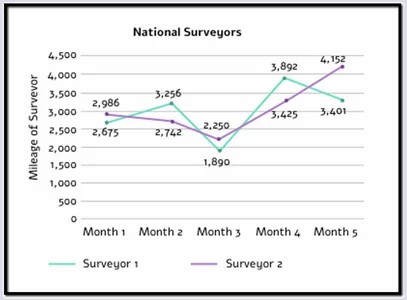
Between which two months was there the smallest proportional increase or decrease in the mileage of Surveyor 1 in comparison to the previous month?
A) Months 1 and 2
B) Months 2 and 3
C) Months 3 and 4
D) Months 4 and 5
E) Cannot say
Verbal reasoning test question
If the first two statements above are true, is the third statement true?
A) Mr. Brown's rabbits are grey.
B) All grey creatures are kind.
C) Mr. Brown's rabbits are unkind.
Diagrammatic reasoning test question
Which set does the Figure belong to?
A) Set A
B) Set B
C) Neither set A nor set B
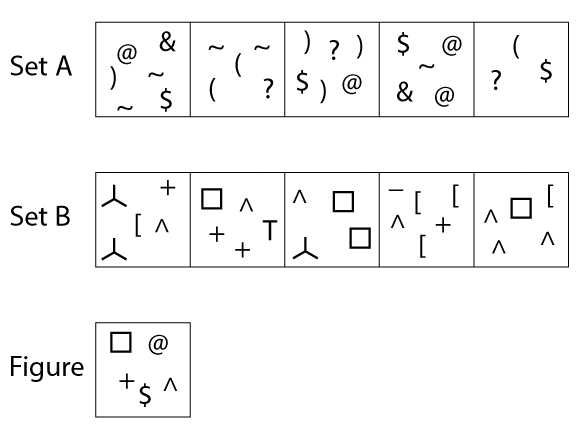
Situational judgement test question
You manage a team of 10 people. Your employees are competent and cooperative. However, you noticed that lately they tend to take long coffee breaks and work rates seem slower. You are happy there is a good atmosphere in the office, but feel uncomfortable about the effect it is having on your employees' work.
What would be the best response?
A) Announce that from now on, any employee who wants to take a break should speak to you first.
B) Decide that at any given time only one employee can take a coffee break.
C) Discuss the situation with the team and ask for their cooperation.
D) Announce deadlines for each task the team gets, and reprimand employees who don’t finish their tasks on time.
Inductive reasoning test question
Look at the sequence of images. Then pick the image that goes with Z the same way that Y goes with X.
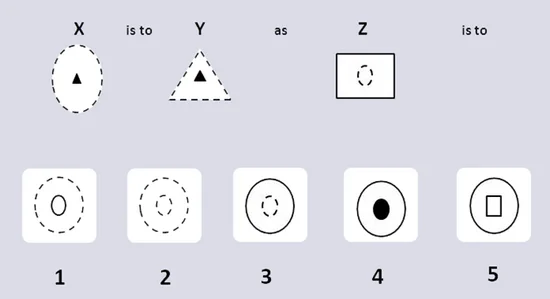
Mechanical reasoning test questions
Which fisherman has to pull his fishing rod harder in order to lift the caught fish?

A) 1
B) 2
C) Both have to apply equal force
D) There is not sufficient data
Abstract reasoning test question
Look at the two sets of shapes. Then determine whether a test shape belongs in Set A, Set B or neither.
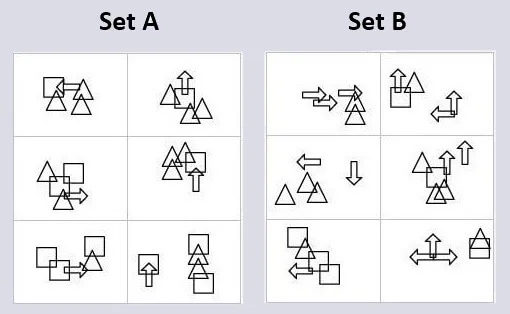
The following test shape belongs to:

A) Set A
B) Set B
C) Neither
Spatial awareness test question
When put together properly, the top three puzzle pieces will create one of the following shapes (A-E).
Note that a side marked X has to touch X and a side marked Y has to touch Y. Choose the correct answer.
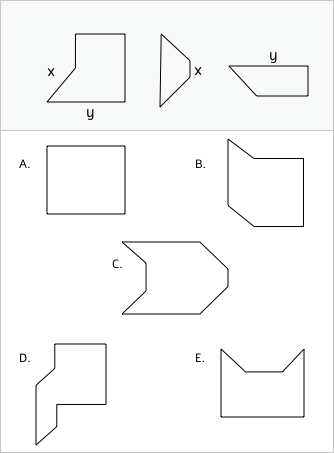
Error checking test question
Which is the correct version of Landec Limited's status?

Thomas aptitude assessment
At Thomas International, we empower businesses to recruit, retain and develop the right people for each role. Our selection of aptitude tests deliver psychologically proven results supported by more than 35 years of experience and expertise.
Incorporating our range of candidate aptitude tests, you can quickly determine whether someone will be the right fit for your business. Delivering objective and meaningful data, you can make informed decisions throughout the recruitment process to achieve higher results time and time again.
Thomas International is registered with the British Psychological Society and audited against technical criteria established by the European Federation of Psychologists’ Associations.




